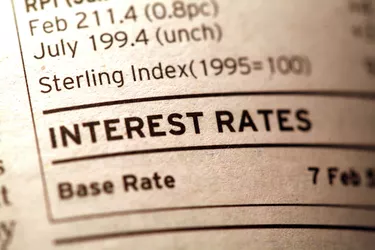
Higher interest rates raise the cost of borrowing money, but they also mean higher income for people who depend on bond portfolios or retirement funds for their income. While corporations growl that they must pay more to fund inventories or build factories, insurance companies occasionally reduce their policy premiums. It seems logical that low interest rates would be better than high interest rates, but that is not necessarily true.
Incentive to Save
Video of the Day
When a savings account or government bond pays a high rate of interest, people are more likely to leave their money in savings rather than spending it. However, if interest rates are high because inflation is strong, as was the case in the early 1980s in the United States, people tend to buy high-ticket items such as diamonds, gold and art as hedges against inflation. High interest rates are not always accompanied by rapid asset price appreciation.
Video of the Day
High Fixed Income
Retirement funds, insurance companies and educational endowments benefit from higher interest rates, as does anyone who depends on bond investments for his income. These funds, as well as banks and other lending institutions, can meet their target investment returns through more conservative credit quality portfolios. During low interest rate periods, funds and banks are tempted to invest in low-quality credits to meet their income needs, but during high interest rate periods they can lock in high investment and loan income by extending their maturities as far as possible.
Moderating Prices
When an economy is overheating due to strong business growth, the Federal Reserve will tighten monetary policy and raise interest rates to discourage speculative trading funded by low interest rates and easy lending of money by banks funding excessive business and consumer spending. When a lot of money is chasing few goods, prices will rise and low interest rates will supply inexpensive money to the system. Higher rates will remove money from the system, business will slow and prices of goods, particularly food and fuel, will decline.
High Reward for Risk
When U.S. Treasury securities are paying a high rate of interest, any additional risk is well rewarded with a risk premium of significantly higher interest. During periods of low interest rates, the risk premium tends to flatten.
Stronger Currency
Higher interest rates in a country, particularly the United States, attract investment from other countries. This means the currency strengthens because foreign buyers of the country's bonds must first buy the currency in order to complete the purchase transaction. This places demand on the currency and it rises in value relative to other currencies. Higher currency values reduce the cost of imported products, helping to lower prices of consumer goods, food and fuel.
Lower Cost of Retiring Debt
When a government must issue bonds to pay for economic stimulus, as the U.S. did in 2009, higher interest rates in later years allow that country's Treasury to purchase back bonds at much lower prices. For example, a 2 point increase in interest rates will reduce the bid on 30-year Treasury bonds from $1,000 to $750 per bond.